Another method of bending mild steel pipe is by the application of heat. The high temperatures required can only be achieved by the use of oxy/acetylene welding equipment. One advantage of heat bending is that pipes can be bent to different radii. In order to achieve an accurate band radius the pipe should first be loaded with sand. The sand should be fine and dry and compressed as much as possible into the pipe. The purpose of the sand is to prevent the pipe from collapsing, wrinkling and flattening during the bending process by supporting the internal walls of the tube.
When bending a pipe to any radius it should be remembered that you are constructing part of a circle.
The parts of a circle relevant to a plumber are:
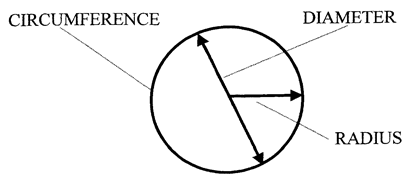
Every circle has 360°, as shown below.
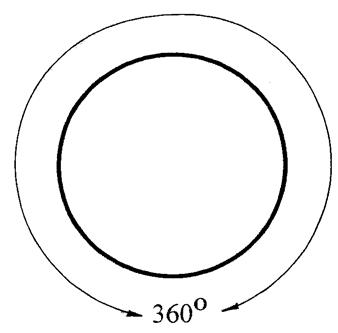
Therefore, there are four 90° segments in every circle.
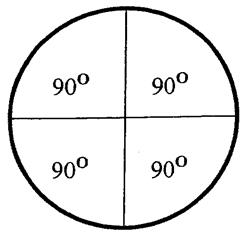
A 90 bend involves bending a pipe through ¼ of a circle.
In the following examples the following abbreviations will be used:
C = CIRCUMFERENCE
R = RADIUS
D = DIAMETER
Calculate the total length of heat required to bend a pipe through 90° to a radius of 75mm.
To carry out this calculation we must find the length of the circumference and divide it by 4:
If R = 75mm Then D = 150mm
C = π D Where π = 3.142
Therefore: C = 3.142 X 150mm
C = 471mm
LENGTH OF HEAT = 471 ÷ 4 = 117.75
Which can be written as 118mm.
A pipe is to be bent to a radius of 125mm and to an angle of 90°. Calculate the total length of heat required for this operation.
If R = 125mm Then D = 250mm
C = π D Where π = 3.142
Therefore: C = 3.142 X 250mm
C = 786mm
LENGTH OF HEAT = 786 ÷ 4 = 196.5mm
Which can be written as 197mm.
Calculate the length of heat required to bend a pipe through 90° to radius of 100mm.
If R = 100mm Then D = 200mm
C = π D Where π = 3.142
Therefore: C = 3.142 X 200mm
C = 628mm
LENGTH OF HEAT = 628 ÷ 4 = 157mm.
Some knowledge of the ways in which heat is transferred is necessary to understand fully the working principles of central heating and hot water systems. There are three methods of heat transfer – conduction, convection and radiation. Each of these will be discussed separately.
Conduction is the transfer of heat through or along a solid. If you hold a metal rod and heat up one end with a blowtorch the other end would soon become warm. This is because the heat is being transferred through the metal. Heat travels through all materials but the speed at which it travels varies. The faster the heat travels the better the material is at conduction.
Convection is a form of heat transmission peculiar to liquids and gases. Water and air are typical materials in which it occurs. Very briefly, it may be described as the transmission of heat by the actual movement of particles of liquid or gas. This movement is caused by the change in the particles’ weight brought about by a variation in their temperature.
This form of heat transfer explains the movement of heated gases up a fuel pipe or chimney; the movement of water through the circulatory pipework of a hot-water system; and the movement of heated water around the pipework and radiators of a central heating system. It also explains the movement of warmed air around a room.
Radiation is the transfer of heat energy in the form of straight lines. Radiant heat will pass through the air without appreciably warming it. The heat from the sun is a good example of radiant heat as it travels through millions of miles of space to reach the earth. This heat will also pass through the air without appreciably warming it, but any solid object obstructing the rays will become warmed by them.
The rate at which a surface absorbs heat depends upon its colour. A blackened surface is an excellent absorber of heat as well as an excellent emitter. Objects that are good absorbers of heat are also good emitters. A surface that is painted silver will not absorb or emit heat readily.
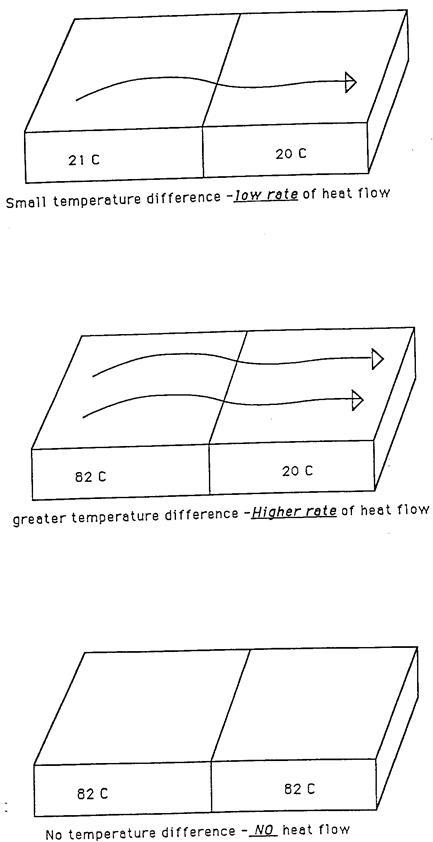
The transference of heat through or along a solid
Copper GOOD CONDUCTORS
Aluminium
Iron
Glass
Brick
Water
Wood
Still Air BAD CONDUCTORS
Convection
The transference of heat through a Liquid or a Gas.
Example
Liquid: The water in a hot water cylinder is heated from the boiler below by convection currents.
Gas: Smoke from a fire is carried up the chimney by convection currents.
Radiation
The transference of heat from its source to another solid object through Air or Space.
Some Examples
From the Sun to You.
From a Fire to You.
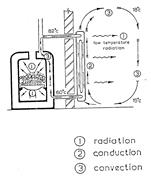
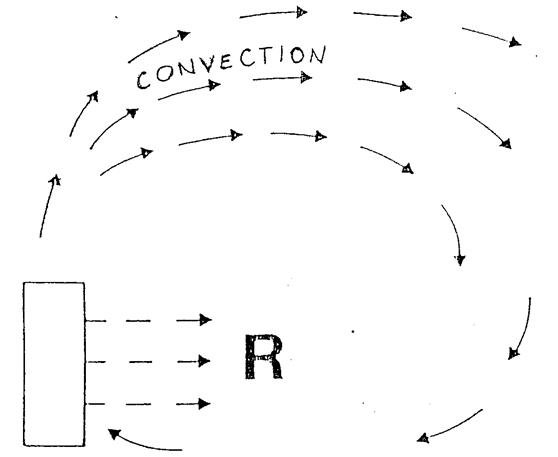
Temperature is a description of heat or coldness measured on any one of several scales. The temperature of a substance determines whether heat shall flow into it or out from it, normally heat flows from the hotter to the cooler substance. If two materials at different temperatures are placed in contact with one another, heat will flow from the hotter to the cooler material, and will continue to do so until the difference in temperature disappears. Furthermore, the greater the difference in temperature, the faster will be the rate of flow of the heat. Thus heat will flow from a hot radiator to warm up the air around it, but on the other hand it will also flow through the walls of a warm building to be wasted in the cooler air around it.
There are three temperature scales in general use, the Fahrenheit, the Celsius and the Kelvin scales.
The Kelvin scale is used in scientific work and 0º Kelvin, which is 273 degrees below 0º Celsius, is referred to as absolute zero – the lowest temperature theoretically obtainable.
1ºK covers the same interval of temperature as 1ºC
For Example, 10ºK equals - 263ºC
Likewise, 100ºC equals 373ºK
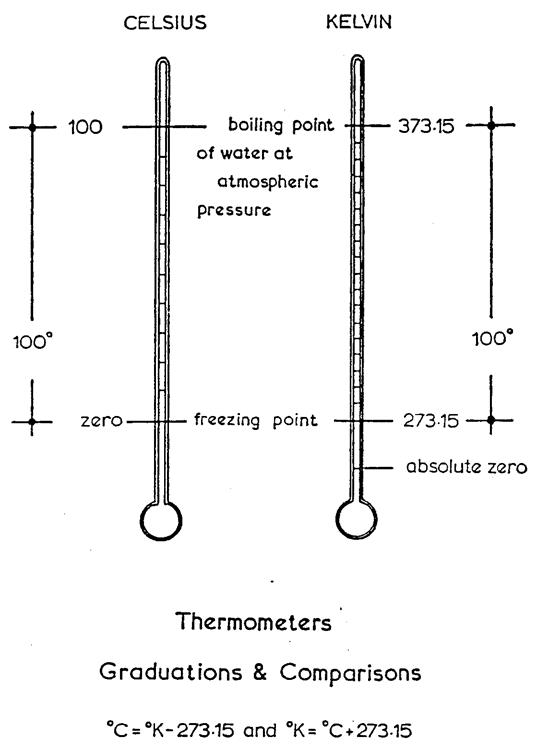
Annealing is the treatment of a metal or alloy to reduce its brittleness and improve its ductility. Annealing is often referred to as the softening of a metal. If a metal becomes work hardened it may require softening before work is continued, otherwise it might fracture. Annealing is achieved by the application of heat.
Copper pipes are annealed before spring bending. The pipe is heated to a dull red colour and then allowed to cool or quenched in cold water.
Tempering or hardening, is a process of improving the characteristics of a metal, especially steel. Tempering is carried out by heating the metal to a high temperature and then cooling it, usually by quenching it in oil or water.
Cold chisels, screwdrivers, bending springs and the jaws of stilsons are examples of tools which are tempered.
Anders Celsius was born in Sweden in 1701. He was professor of astronomy at the University of Uppsala from 1730 until 1744.
In the year 1736 he took part in an expedition to Lapland which verified Newton’s theory that the earth is somewhat flat at the Poles.
In 1740 he built an observatory at Uppsala and two years later devised a temperature scale in which one degree was taken as one hundredth part of the interval between the freezing point and boiling point of water. In the original scale Celsius had water freezing at 100º and boiling at 0º. The scale was reversed three years later after his death and has remained in use ever since.
For many years this scale was referred to as the Centigrade scale but it was officially renamed Celsius in 1948.
Before his death in 1744, Anders Celsius published several papers on astronomy, the most important of which was a method of determining the distance of the Earth from the Sun.
Any of several great scientists could be called the farther of British physics, but William Thomson (Lord Kelvin) heads the list. Thomson uncovered principles in geology, mechanics, hydrodynamic, thermodynamics, and electricity. Perhaps his greatest gift was a powerful ability to turn experimental questions into mathematical problems, and then to translate the results back to practical applications. In fact, he was distinguished both as an electrical engineer and as theoretical physicist. He breathed new life into British physics, and earned the respect of his colleagues and countrymen.
William Thomson’s approach to life was always one of active curiosity. As a young boy, he and his older brother played with spinning tops and soap bubbles in an effort to understand why they behaved the way they did. Many years later, Thompson could still occasionally be found in the study blowing soap bubbles. Since his father was a professor of mathematics at the University of Glasgow, Williams’s curiosity was fostered and encouraged at home. Both he and his brother, James, often attended their father’s lectures and blurted out answers before the other students. Although Williams never had any children of his own, his household was always buzzing with nieces and nephews who shared in their uncle’s curiosity and tried to help as well as they could.
Thomson’s initiation into theoretical physics came when he was sixteen. In the summer before he entered Cambridge, he avidly read Fourier’s Theorie Analytique de la Chaleur and Laplace’s Mecaniique Celeste. It quickly became clear that the young boy’s mathematical abilities were astonishing. Before graduating from Cambridge in 1845, he placed second in the famed Mathematical Tripos examination and later won the Smith prizes. His professors agreed that he was the most creative of all their students. Thomson quickly focused his powers on electrical theory. He worked to reconcile the various approaches of Faraday, Poisson and Coulomb. He set the stage for Maxwell’s theory, but never quite accepted it as the last word. As his investigations increased in number, they also increased in breadth. He jumped into the theory of thermodynamics where he made several contributions including the definition of the Kelvin scale of absolute heat content.
Despite hundreds of honors, Thomson forever maintained that his best efforts resulted in failure. He was a modest man with patience that ultimately yielded progress. Socially, Thomson had a good sense of humor, an infectious laugh, and a friendly disposition. He loved playing game, and became absorbed in whist although the other players had to periodically remind him what a trump was. At one gala picnic, he was introduced to a young woman and he offered to fetch her an ice cream cone. She wondered out loud how anyone could make ice cream when it was so warm outside. To her subsequent delight, Thomson carefully explained the process. He had a talent for making the complex understandable to the layman. His kindness carried over to animals and, in particular, to his pets. His parrot, Dr. Redtail, was a favourite companion, and together they spent many hours whistling melodies. In what spare time he could find, Thomson loved to sail his yacht, the Lall! Rookh. It was on one of his cruises that he met his second wife.
After being knighted earlier, William Thomson became Lord Kelvin in 1892. This was only one of the many honors he received. His final honor came in 1907 when he was buried next to Sir Isaac Newton in Westminister Abbey.
Source: http://local.ecollege.ie/Content/APPRENTICE/liu/Plumbing_notes/Heat_Bending_M1_U11.doc
Web site to visit: http://local.ecollege.ie/
Author of the text: indicated on the source document of the above text
If you are the author of the text above and you not agree to share your knowledge for teaching, research, scholarship (for fair use as indicated in the United States copyrigh low) please send us an e-mail and we will remove your text quickly. Fair use is a limitation and exception to the exclusive right granted by copyright law to the author of a creative work. In United States copyright law, fair use is a doctrine that permits limited use of copyrighted material without acquiring permission from the rights holders. Examples of fair use include commentary, search engines, criticism, news reporting, research, teaching, library archiving and scholarship. It provides for the legal, unlicensed citation or incorporation of copyrighted material in another author's work under a four-factor balancing test. (source: http://en.wikipedia.org/wiki/Fair_use)
The information of medicine and health contained in the site are of a general nature and purpose which is purely informative and for this reason may not replace in any case, the council of a doctor or a qualified entity legally to the profession.
The texts are the property of their respective authors and we thank them for giving us the opportunity to share for free to students, teachers and users of the Web their texts will used only for illustrative educational and scientific purposes only.
All the information in our site are given for nonprofit educational purposes